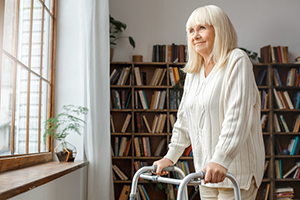In a Canadian population-based cohort study reported in JAMA Surgery, Chesney et al found that older patients undergoing surgery for cancer were likely to spend a high number of days at home vs in health-care institutions in the years following surgery for cancer, suggesting favorable functional outcomes in this population.
Study Details
The study involved data from 82,037 patients in Ontario age 70 or older. Patients had a new diagnosis of cancer between January 2007 and December 2017 and underwent resection 90 days to 180 days after diagnosis. Patients were followed until—and censored at—date of death, date of last contact, or the end of December 2018. Patients had a mean age of 77.5 years, and 63.5% of patients were women.

Photo credit: Getty
The main outcome measure was time at home, categorized as high time at home (defined as ≤ 14 institution days per year) and low time at home (defined as > 14 institution days per year) during the 5 years after surgical treatment. An institution day was any day spent in inpatient acute care, emergency department, inpatient mental health care, inpatient rehabilitation, or a long-term care facility.
Key Findings
Median follow up was 46 months (interquartile range = 23–80 months).
The median number of days at home per days alive per patient for postoperative years was 0.98 in year 1, 0.99 in year 2, 0.99 in year 3, 0.99 in year 4, and 0.99 in year 5.
The probability of high time at home was 70.3% in year 1, 61.0% in year 3, and 53.2% in year 5.
In analysis of time at home in each postoperative year conditioned upon survival in the previous year, loss of time at home was highest in postoperative year 1, particularly in the first 60 days after surgery. Thereafter, the probability of high time at home decreased by < 10% overall, from 97.3% to 88.2% for year 2, 96.7% to 88.2% for year 3, 95.9% to 87.6% for year 4, and 95.2% to 87.1% for year 5.
Factors associated with increased likelihood of low time at home included:
- Advancing age (≥ 85 years; hazard ratio [HR] = 2.11, 95% confidence interval [CI] = 2.04–2.18)
- Preoperative frailty (HR = 1.74, 95% CI = 1.68–1.80)
- High material deprivation (5th quintile; HR = 1.25, 95% CI = 1.20–1.29)
- Rural residency (HR = 1.14, 95% CI = 1.10–1.18)
- High-intensity surgical procedures (HR = 2.04, 95% CI = 1.84–2.25)
- Gastrointestinal (HR = 1.23, 95% CI = 1.18–1.27) and gynecologic (HR = 1.31, 95% CI = 1.18–1.45) cancers.
Factors associated with increased likelihood of high time at home included:
- Female sex (HR = 0.89, 95% CI = 0.87–0.91)
- More recent year of diagnosis (HR = 0.83, 95% CI =0.81–0.85).
Inpatient acute care was responsible for 76.0% and long-term care for 2.0% of institution days in postoperative year 1. The proportion of institution days accounted for by inpatient days decreased to 31.0% by year 3, with days in long-term care accounting for an increased proportion of institution days over time.
The investigators concluded, “This study found that older adults predominantly experienced high time at home after resection for cancer, reflecting the overall favorable functional outcomes in this population. The oldest adults and those with preoperative frailty and material deprivation appeared to be the most vulnerable to low time at home, and efforts to optimize and manage expectations about surgical outcomes can be targeted for this population; this information is important for patient counseling regarding surgical cancer treatment and for preparation for postoperative recovery.”
Julie Hallet, MD, MSc, of the Division of General Surgery, Sunnybrook Health Sciences Centre–Odette Cancer Centre, Toronto, is the corresponding author for the JAMA Surgery article.
Disclosure: The study was funded by grants from the Canadian Institutes of Health Research and Ontario Institute for Cancer Research. For full disclosures of the study authors, visit jamanetwork.com.

